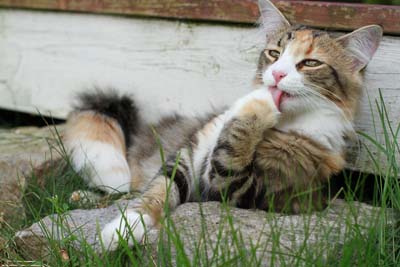
Most cat owners are all too familiar with the gagging, hacking sounds of a cat being troubled by a hairball. While we like to joke about hairballs, and they are sometimes harmless, these wads of fur, known to veterinarians as trichobezoars, can actually cause – or be the result of – some serious problems.
April 24 is Hairball Awareness Day, and these are some things you should know:
Hairballs are sometimes found in animals who lick to groom and end up swallowing hair. Cats are usually the first animals you think of when you think of hairballs, but other animals, including rabbits, dogs, ferrets, and even cattle and other cud-chewers, can get hairballs.
In a healthy animal, most of the hair just passes through the digestive system. When hair stays in the stomach, it can accumulate and form a ball. The result are those lovely, tube-shaped balls of hair that your cat might vomit on the rug.
Why are hairballs bad?
Aside from your cat hacking them up on the rug, hairballs can actually cause several problems, including:
- Upset stomach leading to vomiting of food and mucus
- Decreased appetite
- Constipation
- Lethargy
- In rare cases, a hairball scan get stuck in the esophagus or cause an intestinal blockage, and your cat might need surgery to remove it.
In addition, hairballs can actually be a sign that there’s something wrong with your cat’s digestive system. Cats should be able to pass most of the hair they swallow without any issues, so if they aren’t, it could be due to an underlying issue, such as inflammatory bowel disease or cancer.
When should I call my veterinarian?
- If your cat seems to be gagging on a hairball, and this continues for more than one day without the cat actually producing one, call your veterinarian.
- Remember that vomiting in cats is not normal and can actually be a sign of a number of different problems. If your cat vomits a lot, with or without hairballs, call your veterinarian.
- Any time your cat seems to be ill or in distress, call your veterinarian.
Can hairballs be prevented?
There are a few things you can do to help reduce hairballs in cats. For example:
- Brush your pet and be sure to remove any loose hairs that remain when you’re done.
- If your cat seems to groom compulsively, make sure she has plenty of stimulation so she doesn’t get bored. Lots of toys, and things to scratch and climb, can give her other things to think about.
- There are foods designed to fight hairballs in cats – talk to your veterinarian to see if one of these might be appropriate for your cat.
Remember that hairballs can be due to a serious underlying issue, so if it your cat’s hairballs aren’t easily resolved, call your veterinarian!